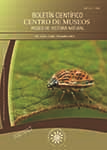Autores/as
Resumen
Con el propósito de explorar caracteres micromorfológicos en Pecluma eurybasis var. villosa (Polypodiaceae) se observó el desarrollo del esporangio y de sus estructuras acompañantes, haciendo uso de las técnicas de microscopía óptica (MO) y microscopía electrónica de transmisión (MET). Se identificó la formación de un tapete uniestratificado y de parafisos obtusos no claviformes como caracteres potencialmente importantes en la sistemática del género.
Citas
BILDERBACK, D.E. 1978. The ultrastructure of the developing sorophore of Marsilea vestita. American Journal of Botany 65: 638-645.
EVANS, A.M. 1968. Interspecific relationships in the Polypodium pectinatum-plumula complex. Annals of the Missouri Botanical Garden 55: 193-293.
EVERT, R.F., R.D. WARMBRODT & S.E. EICHHORN. 1989. Sieve-pore development in some leptosporangiate ferns. American Journal of Botany 76: 1404-1413.
GIUDICE, G.E., M.A. MORBELLI & M.R. PIÑEIRO. 2000. Palinological analysis of Doryopteris species (Pteridaceae/Pteridophyta) from north-west Argentina. Grana 39: 279-287.
HENNIPMAN, E., P. VELDHOEN, K.U. KRAMER & M.G. PRICE. 1990. Polypodiaceae. pp. 203-230. En: KRAMER, K.U. & P.S. GREEN (Eds. vol.) Pteridophytes and Gymnosperms. En: KUBITZKI, K. (Ed. gral.) The families and genera of vascular plants. Vol 1. Springer-Verlag. Berlín.
KESSLER, M. & A.R. SMITH. 2005. Seven new species, 13 new combinations, and one new name of Polypodiaceae from Bolivia. Candollea 60: 271-288.
MAKGOMOL, K. & E. SHEFFIELD. 2001. Gametophyte morphology and ultrastructure of the extremely deep shade fern, Trichomanes speciosum. New Phytologist 151: 243-255.
PRICE, M.G. 1983. Pecluma, a new tropical American fern genus. American Fern Journal 73:109-116.
ROMERO DE PÉREZ, G. 2003. Microscopía electrónica de transmisión (MET) área biomédica: teoría y práctica. Academia colombiana de ciencias exactas, físicas y naturales. Colección Julio Carrizosa Valenzuela Nº 12. Bogotá.
SCHMID, E. & F. OBERWINKLER. 1995. A light- and electron-microscopic study on a vesicular-arbuscular host-fungus interaction in gametophytes and young sporophytes of the Gleicheniaceae (Filicales). New Phytologist 129: 317-324.
TRIANA-MORENO, L.A. 2009. El género Pecluma (Polypodiaceae) en Colombia. Aproximación filogenética y revisión taxonómica. Tesis de Maestría. Universidad Nacional de Colombia, Bogotá.
TRIANA-MORENO, L.A. 2011. Novedades en Pecluma (Polypodiaceae). Brittonia 63: 62-65.
WILSON, K.A. 1958. Ontogeny of the sporangium of Phlebodium (Polypodium) aureum. American Journal of Botany 45: 483-491.
WILSON, K.A. 1959a. The sporangia of three problematic species of Polypodium. American Fern Journal 49:147-151.
WILSON, K.A. 1959b. Sporangia of the fern genera allied with Polypodium and Vittaria. Contributions from the Gray Herbarium of Harvard University 185: 97-127.

 PDF
PDF
 FLIP
FLIP



















